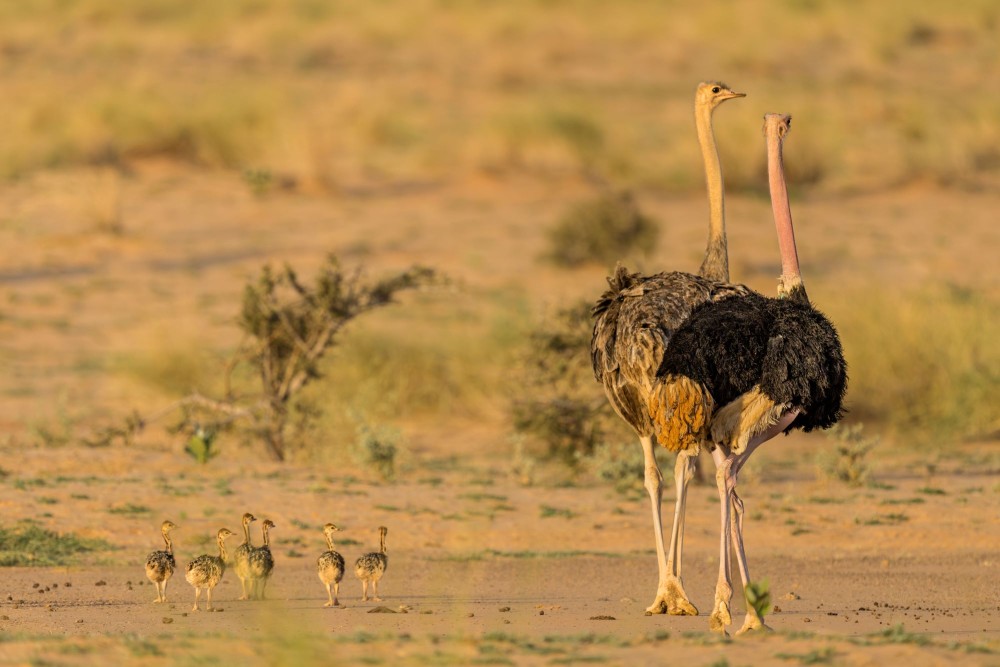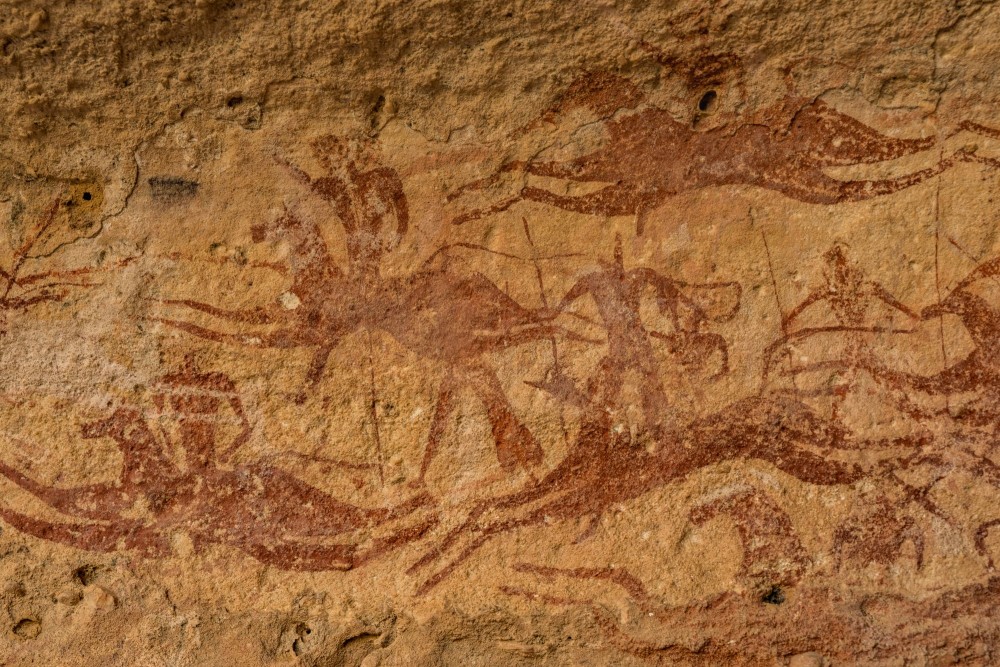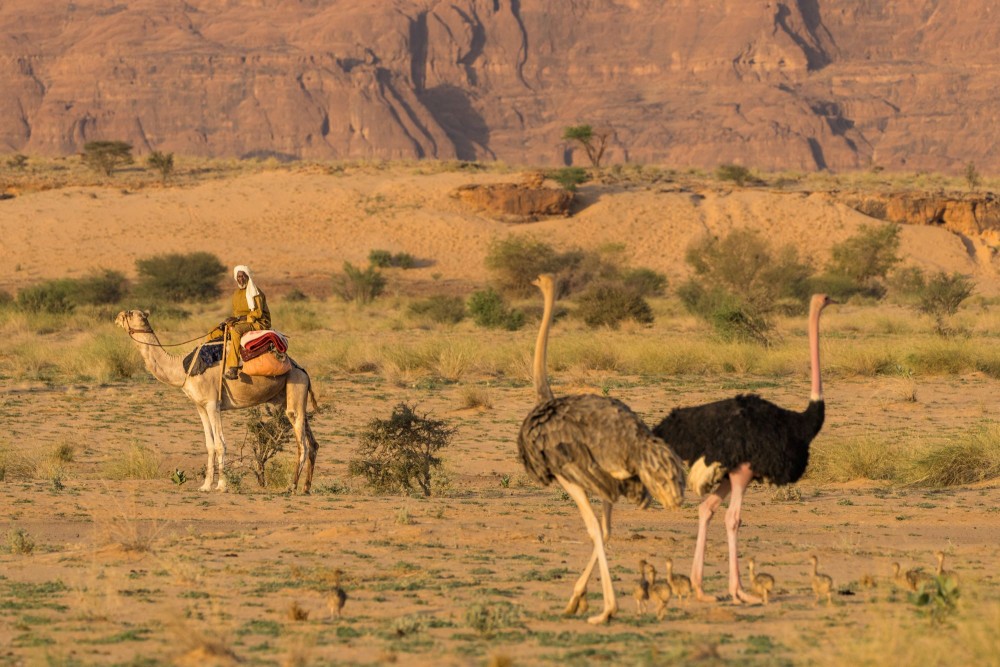With 20 new chicks, the endangered red-necked ostrich has been returned to Ennedi, helping to restore this ancient land
In November 2023, 20 baby red-necked ostriches could be seen running behind their parents across the sands of Ennedi Natural and Cultural Reserve. They are a sign of a successful translocation process of 19 birds from Zakouma National Park to Ennedi, ensuring the sustainability of our efforts and helping to secure the long-term survival of this magnificent species.
In caves and on eroded rocks that dot the Ennedi Plateau, paintings created hundreds and thousands of years ago by the ancient inhabitants of this area portray an array of humans and animals. Amongst the people, cows, antelope and lion that decorate the walls dance large birds – the ostriches of the desert.
While this prehistoric rock art reflects a time when the region was wet and lush, Ennedi’s perennial springs can still sustain an astonishing number and diversity of wildlife. That is, until the mid-20th century when poaching and regional conflict eradicated many species, including two Sahelo-Saharan specialities: the addax antelope and the red-necked ostrich.
In 2018, African Parks and the Chadian Government began a partnership along with the local communities to restore this ecosystem, with the Ennedi Natural and Cultural Reserve proclaimed in 2019. As a result, Ennedi has become a sanctuary for iconic mammals such as Barbary sheep, dorcas gazelle, and striped hyaena. By 2021, it was time to bring back the ostrich.
The Largest Bird in the World

At 2.7 metres high and weighing nearly 150 kg, the red-necked ostrich is the largest bird alive today. Also known as the North African ostrich, it was once common across the entire Sahelo-Saharan region, but today it is critically endangered, found only in small, scattered pockets. One of those pockets is Zakouma National Park, also in Chad, where since 2010, African Parks and the Chadian Government have partnered in managing the park. With poaching on the decline, wildlife numbers have stabilised or even grown. Today, Zakouma has some 250 ostriches, and therefore was the logical place from which to source a founder population for Ennedi.
How to Move an Ostrich
Moving an ostrich is unexpectedly challenging. Ostrich chicks are notoriously difficult to breed and raise successfully. Meanwhile, despite their large size and hardy appearance, adult ostriches are prone to severe injuries when being handled and moved. With all this in mind, the Ennedi team decided to capture two-month-old wild-born chicks, hoping that they had already learnt a little from their parents but were still young enough to withstand the rigours of translocation.
After a few months of observation and learning, the move began. Anyone visiting Zakouma during this time might have been bemused to see a group of people striding confidently and rapidly across the savannah towards an ostrich family, chasing the adults away and picking up a youngster. As dawn broke, the birds were carefully placed in an aircraft. For flightless birds, they travelled very well, sleeping at high altitude in the cool, turbulence-free conditions. In this way, 63 chicks from eight clutches were captured, half going to Ennedi while the rest were donated to conservation partner Sahara Conservation working in central Chad.
Dancing in the Sand

On arrival, the birds were placed in enclosures specially built to limit human interaction, with night shelters against the winter cold. They were vaccinated and fed a balanced diet of maize, beans, peanuts and plants found on the reserve. With all this care, the majority survived that crucial first year. Not only did they survive, but they thrived – and danced! A healthy chick is a dancing chick, a sight that the team devoted to their care enjoyed every morning at dawn.
When the birds were about six months old, they were moved to an “acclimatisation pen” that mimicked their soon-to-be wild habitat, complete with rocks, holes, grass and trees. Here they remained for another year, cared for by community members trained and supported by African Parks. When the rains arrived, transforming the landscape, the doors of the pen were opened. The ostriches didn’t hesitate. They ran out and loped across the plains, immediately at home in their new environment.
Re-learning to Live Together

Since then, they have settled down and are very relaxed in the presence of humans, gravitating towards villages. Here, the people are eager to see them, always taking a moment to watch their new neighbours get comfortable. Sometimes, a little too comfortable… so the team in the field is never far away, monitoring their every move, and helping the communities understand their new neighbours. In this way, people and birds are learning to live together, here in the Sahara.
Ennedi is now the proud home to a wild population of red-necked ostriches that are spreading out and recolonising the place where they once roamed long ago. Indeed, in November 2023, four couples within the wild population nested, and a bumper number of 20 baby ostriches hatched, bringing the total population up to 53 individuals and with more to come.
November 2023 also saw ten addax antelope joining the birds in being reintroduced to the reserve. Live ostriches and antelope that now dance and plod across the plateau echo the painted forms that illuminate the rock formations, reconnecting Ennedi’s people with their identity and culture, their past and present.
12 December 2023 – Ilana Stein, Guest Blogger
Your Support Goes a Long Way
At African Parks we are working everyday to protect Africa's last wild landscapes. By donating to us, you are making a difference and are giving hope to people and wildlife across the continent.
Donate